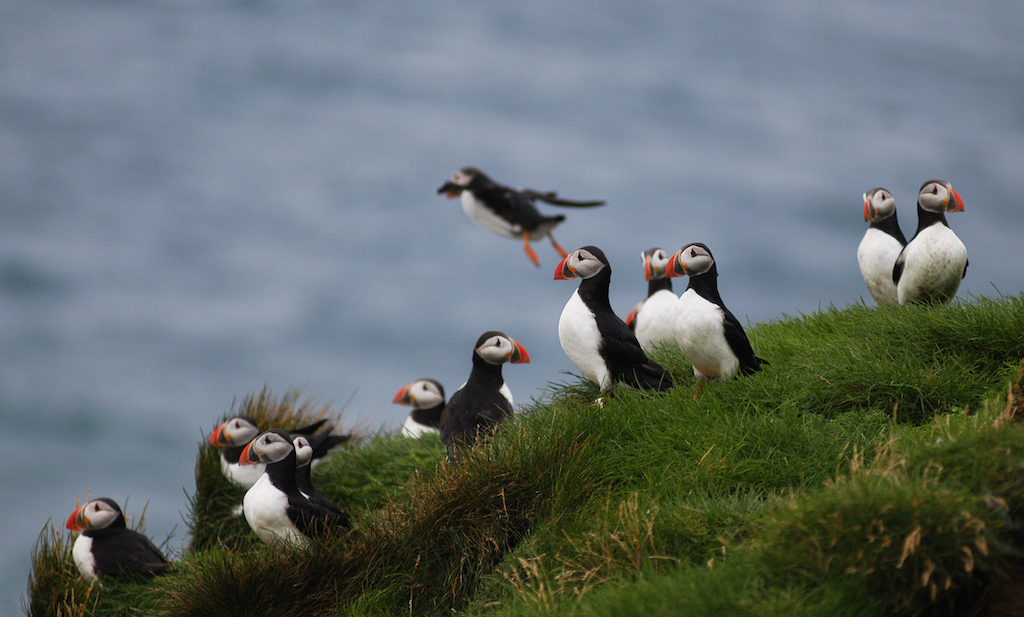The fascinating Puffins of Iceland

Fast and furious creatures of the sea
By Eileen Ogintz
Don’t expect them to win a parents of the year contest. Not the Puffins of Iceland.
They fly away and leave their little chicks when they are just six weeks old to fend for themselves, explains Mariana Veloso. She is a marine biologist with a master’s degree who is our guide on a 90-minute Elding Puffin Watching tour to Lundey, which literally means “puffin island.” Elding also offers whale watching tours.
“When the little pufflings get hungry they just leave,” explained Veloso, and will stay at sea until they are four or five years-old.
[Photos by Andy Yemma unless otherwise noted – cover photo by Elding Adventure at Sea]

We have just finished a two-week Abercrombie & Kent Arctic Exploration cruise. We saw walrus, whales, all varieties of sea birds, even a mama Polar Bear and her cubs from a distance but we didn’t see any Puffins.
As 40 percent of the world’s puffin population—some 10 million puffins every summer—come from Iceland, I didn’t want to leave without seeing these amazing little birds who can fly as fast as 55 mph, flapping their wings 400 times a minute. You’ve seen pictures of these small birds with their distinctive bright orange beaks.

A few fun facts, courtesy of Mariana Veloso. They typically mate for life and return to the same burrow they have created in the dirt for the summer where they lay their sole egg. It is up to the male puffin to clean and deepen the burrow each year. “That’s how we tell the males apart because their chests are dirty from all the dirt early in the summer,” she explained.

The “couple” will spend winters apart and when meeting again, they connect with a behavior called “billing,” slapping their beaks together. And when their “pufflings” have matured, at four to five years old, they also will return to the same place to find a mate and start the whole process again. They must catch 450 fish a day to feed their pufflings and must try to avoid the larger gulls who will steal the fish right from their mouths.
Elding is a company that has been around for many years and helped pioneer whale watching here. Go out in winter or summer. We were on a relatively small boat with fewer than 20 people. The whale watches are on larger vessels.
Elding strictly adheres to IceWhale’s codes of conduct for responsible whale watching, complemented by its own rigorous guidelines. Dedicated to leading in environmentally sustainable tourism, Elding holds Platinum EarthCheck certification. Its environmental commitment was acknowledged with a nomination for the Nordic Council Environmental Award in 2018. More information about responsible tourism here.

We spent the morning at the Reykjavik Maritime Museum learning the history of the fishing industry here. It wasn’t an easy life and one that children were part of, helping to lay the fish out to dry and then pack them. “I never remember it as hard work or child labor,” a former teacher recalls in a video. For centuries, drying was the most common method used here to preserve fish — drying them outdoors in the sun and salting them. In the early 20th Century, this was Iceland’s export commodity, with women and children pitching in to help.
There are many interactives for kids and people explaining the artifacts-from coffee cans used on board, to the “no knitting on Sundays” rule. It seems that Icelanders, who made many wool socks, mittens, and sweaters for the fishermen, regarded knitting on Sunday as bad luck.

Icelanders today catch some 60 million cod each year and use all parts to make various products including medicine from fish liver, oil, collagen, and more. There were also some good lessons on climate change, like what happens to the soda can you threw in the ocean. A large amount of waste washes up on Iceland’s shores and the country’s Environment Agency is studying how it accumulates and remove it.
If you plan to take in some of Reykjavik’s major museums including the National Museum of Iceland, the Reykjavik Art Museum, the Reykjavik Zoo and Family Park as well as many of the city’s thermal pools, invest in a City Card, as it also includes Reykjavik City Buses and Videy Island ferries as well as discounts at various restaurants and tours.
We are staying at the Reykjavik Konsulat Hotel, part of the Curio Collection from Hilton and an ideal location in the center of the compact city that is walking distance to the harbor and many of the city’s top attractions as well as restaurants (fish and chips, lobster soup, Arctic char, or perhaps a burger, Thai or Indian), bars, and shops.
Maybe I have time for a little more shopping before we leave… another hand knitted hat perhaps!

